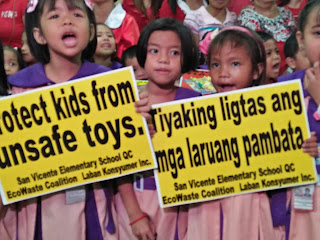EcoWaste Coalition Promotes Children’s Right to Safe Toys ahead of the Christmas Shopping Spree (“Every child deserves a safe toy: Make it happen.”)
With the Christmas holiday season upon us, the EcoWaste
Coalition wasted no time reminding consumers to ensure that children must only
be given toys that will not expose them to harm.
At an event held at San Vicente Elementary School in
Quezon City, the EcoWaste Coalition emphasized society’s responsibility to
provide safe toys that can help a child to discover and enhance her or his
potentials to the fullest.
The event, which has the theme “Every child deserves a safe
toy: Make it happen,” coincided with the celebration of the Universal
Children’s Day on November 20 --- the day when the UN General Assembly adopted
the “Declaration of the Rights of the Child” in 1959 as well as the “Convention
on the Rights of the Child” in 1989.
“The market is flooded with cheap and unregistered toys
whose quality, safety and suitability cannot be guaranteed. Under this situation, consumers, particularly
parents, will have a huge responsibility to play in terms of picking the right
toy for children that will not pose harm to their young bodies and minds,” said
Thony Dizon, Chemical Safety Campaigner, EcoWaste Coalition.
Dizon cited the findings of its recent study in
collaboration with IPEN Chemicals in Products Program indicating the presence
of lead and other toxic metals in 32 out of 100 sampled toys (32%). None of the samples, including a fidget
spinner with 198,900 ppm of lead, provided a list of chemicals that make up a
toy nor provided text or graphic warnings.
The study further revealed that the country’s toy registration and labeling
requirements are not effectively enforced as evidenced by 77% of the samples
providing zero information about their manufacturers and/or distributors, 75%
not indicating License to Operate (LTO) number on the product label, and 75%
failing to meet other required labeling information on the packaging.
In addition to toxic chemicals lurking in toys, Dizon
also pointed to other hazards that may be present in some toys. Toys with small parts may be ingested causing
choking, or, in some instances, get pushed into the nostrils or ears. Toys with pointed or sharp edges may injure
the eyes or cut the skin. Toys with
cords longer than 12 inches may cause strangulation. There are also toys with the potential to
cause blunt force injury or trauma.
Consumer rights advocate Atty. Vic Dimagiba, President of
Laban Konsyumer Inc. stressed the importance of ensuring that toys are
adequately and truthfully labeled. He
said: “The provision of complete and honest labeling information will help
consumers in making an informed choice on what toy to buy for a child. I cannot overstress the importance of product
labeling information, which is an indispensable tool for making the right
purchasing decision.”
Dimagiba also underlined the urgency of enforcing
Republic Act 10620, or the Toy and Game Safety Labeling Act of 2013,
emphasizing that the over-delay in the promulgation of the law’s Implementing
Rules and Regulations “is not serving the best interests of the Filipino child
and is only benefiting the toy industry.”
Dr. Erle Castillo, a toxicologist at Medical Center Manila, cautioned parents
against buying toys that have not passed through the quality and assessment
verification of the Food and Drug Administration (FDA), the government health
agency in charge of regulating toys.
“Some toys may contain undisclosed chemical ingredients
such as lead that can interfere with the growth and development of a child,”
Castillo, a member of the Philippine Society on Clinical and Occupational
Toxicoloy (PSCOT), said. He explained
that chronic exposure to lead even at low doses can affect a child’s health
over time, damage brain development and result to decreased intelligence as
measured by IQ points, lower school performance, and behavioral problems.
The toy safety event concluded with the EcoWaste
Coalition drawing parents’ and children’s attention to the following tips for
choosing safe toys this holiday season:
1. Carefully read
the product label and refrain from buying unlabeled and unregistered toys.
2. Choose toys
that are suited to a child's age, ability and behavior.
3. Watch out for
toys that may cause injury or pose burn, chemical, choking, laceration,
strangulation and other safety hazards.
4. Shun toys that
have small parts such as button batteries and magnets that can be pulled off
and get swallowed by a child.
5. Steer clear of
polyvinyl chloride (PVC) plastic toys that may contain banned phthalates and
other hazardous substances such as cadmium and lead.
6. Refrain from
picking toys that have a strong chemical or perfumed smell.
7. Avoid painted
toys unless labeled as certified lead-safe.
8. Avoid face
paints unless guaranteed free of toxic metals and other cosmetic contaminants.
-end-











Comments